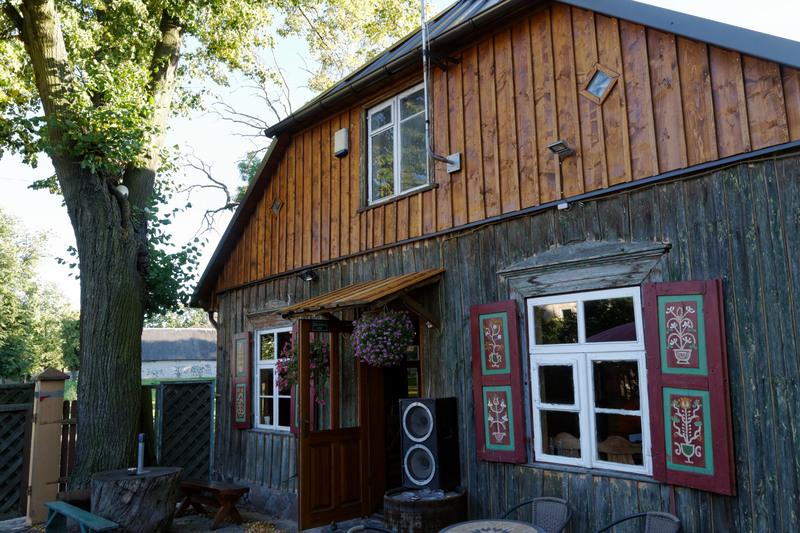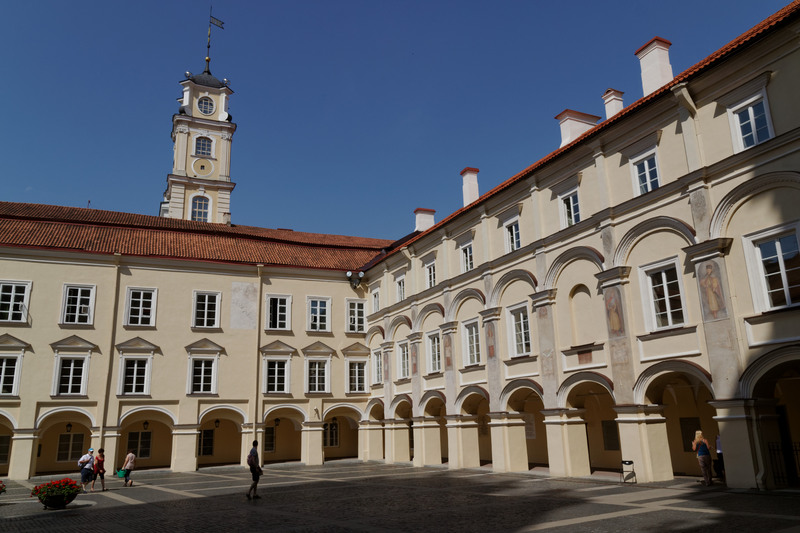Trying to understand Lithuanian beer

Prie Uosio bar in Panevėžys |
Now that I've visited Lithuania three times, and finally gotten to actually meet some of the brewers, I feel I am at last beginning to understand a least a little of Lithuanian beer. This post is my attempt to do a little analysis and put what I've learned into some kind of order.
So, what is it that sets Lithuanian beer apart? The farmhouse ales brewed with unique traditional yeast strains are obviously part of it, but only a part. Lithuania has a whole culture of beer different from the others. Just about every beer in the world is brewed in a style that ultimately derives from either Belgium, England, or what we could call the areas of German culture. Sahti, kvass, and a few others are the only exceptions I can think of, except for Lithuanian beer.
Of course, I should now be able to list a whole set of new Lithuanian styles of beer that nobody's heard of, but the list is actually not that long. So far, all I have is kaimiškas (farmhouse ale), keptinis (the beer style brewed by Ramūnas Čižas), and perhaps duminis (smoke beer, now extinct). The reason for this seems to be that the concept of style is not really used much in Lithuania. Beers are generally named by colour, or have completely individual names.
When we asked Lithuanian brewers what type their beers were they never really had the answer ready. They had to stop and think, and would usually tell us that it was "lager" or "ale". My impression was that they were trying to use terms they assumed would be at least minimally descriptive to us, but that really we were forcing them to put labels on something that didn't really have a label in their minds.

Bačkorių |
This impression is reinforced by the look we got at their brewing methods. Everyone seemed to be doing it in different ways, and producing completely different kinds of beer, even if there still was a kind of family resemblance. As I've written before, it's similar to how Belgian beers resemble one another across styles.
Another way in which I'd say that Lithuania has a beer culture is that beer generally seems to be a more important part of daily life than elsewhere. All kinds of people, of all ages, seem to find it normal to drink beer at any time of day. As you'll see there are also a whole set of customs around the consumption of beer. For a brewer to serve us his beer without having some himself, even if it is only a token amount, seems unthinkable.
Not only that, but they seem to take considerable pride in their beer heritage (entirely reasonably), and to consider it an important part of their own culture. It's also clear that all the places cropping up serving "special" beers are focusing very much on Lithuanians themselves more than on tourists, so the beer renaissance that's taken place in Lithuania is clearly a national affair, and one that foreigners are only now beginning to discover.
In fact, Lithuanians seem to have an unusual degree of awareness of their traditional culinary heritage in general. And that heritage is actually bigger than you'd expect. Lithuanian cheese seems worthy of a study of its own, for example. There's a good number of restaurants offering traditional Lithuanian food, and even a chain focusing on it, called Forto Dvaras. There's even a culinary heritage organization that certifies that restaurant recipes truly follow traditional practices for that particular dish. That organization has listed Ramūnas Čižas and Jovaru Alus on their Lithuanian culinary heritage list, with good reason.
It's worth pointing out that it's not just the beers that are interesting, but also in many cases the bars. Prie Uosio (photo above) and Šnekutis Užupio are among the most unique bars I've ever visited, and several others like Bamb Alynė and Špunka are very, very good. All of these worth visiting even if you don't care about beer at all.
I guess with this background it shouldn't be so astonishing that so many of these beers are of extremely high quality. You may well wonder why, if they are so good, ratings on Ratebeer are not that impressive. I think this has several reasons. One is that many of the beers are just good, rather than outstanding. Another is that many people don't understand what they're drinking. They start with low expectations, find something completely different to anything they've had before, and, in short, "don't get it". Also, quality is sometimes less than consistent.

The Great Courtyard of Vilnius University |
But, most of all, many of these beers don't keep for long, travel poorly, and are not always well treated. The result is that a beer that is a mind-blowing experience at the brewery is often just pretty good in Vilnius, and thin acidic crap by the time it's shared at a tasting in someone's home in Scandinavia. It's a real shame, and something I hope Lithuanian brewers, distributors, and bar owners will work on.
Anyway, this is by any measure one of the world's foremost beer cultures, and one that nobody with an interest in beer can reasonably ignore. So what makes it special? Well, what's special about Belgian beer? Is it the yeast? Partly, but most of all it's the entire culture, a combination of ways of thinking, ingredients, methods, and styles. Lithuania has that, and like the Belgians they owe it to nobody else, and have developed it to a surprisingly high quality.
To give you a better idea of what I'm talking about, let's try and go through some examples of that makes this such a unique culture.
First and foremost in everyone's minds, I think, are the traditional farmhouse brewers, producing beers in the ancient, prehistoric Lithuanian styles, using the equipment, methods, and ingredients of their forefathers. And, amazingly, the ancestral yeast, a species unique to Lithuania. There's a number of these who brew non-commercially, but also quite a few (at least four) who brew commercially.
In the next tier of size up from the farmhouse brewers there are also many very interesting brewers. Most of these seem to have started from a farmhouse brewing background, but to have scaled up and modernized their operations. Some, like Piniavos, Kupiškio and Su Puta, have stuck closely to the original farmhouse style. Others, like Joalda, Davra, and Rinkuškiai, have modernized away from the farmhouse tradition, and seem to me to have invented their own traditions in doing so.

Belmontas brewpub, Vilnius |
Joalda is the example I know best, brewing with a combination of top- and bottom-fermentation, producing what might be the most supremely drinkable beer I have ever tasted. Beers that, amazingly, do not lose their allure after the fifth pint. I know, because I got to try it. Without having the facts to hand (hey, they're not exactly easy to come by), I'm sure there are a whole range of other brewers like Joalda producing unique beers with unique ingredients and methods. Tarušku and Dundulis seem to fit here. Every single one of these breweries is really worth exploring.
A word of caution is in place at this point. Many of these brewers also make strong beers of about 8% in 1-liter PET bottles for poor people who want a buzz. They make a good income from this, but clearly do not put their souls into brewing them. Biržu Alus makes a number of these, and I assume Joalda's Vulkanos falls in the same category.
Another big group are small brewers that seem to be using mostly normal ingredients and methods, but which produce what seems to me beers with recognizably Lithuanian tastes, and of very high quality. I'd put Vasaknų Dvaro, Gintarino, Tores, and a whole bunch more into this group.
Finally, we get to the smaller industrials, a group comparable to the English regional breweries, producing beers that are less unique, of slightly lower quality, but still interesting, different, worthwhile, and drinkable. Like the Joaldas, they also produce some lower-quality beers for necessary income. I'd put at least Biržu Alus, Vilkmerges, and Gubernija in this group.
Of the typically Lithuanian flavours that seem to recur in many of these beers, I think the Lithuanian malts are responsible for the dusty strawy flavours many of the pale beers have. Some people seem to be describing this as a "hay" flavour. Many of the farmhouse-style beers have a very unusual nutty oily flavour, which might come from the yeast, from mashing techniques, or from something else. Strong, deep earthy flavours are very common, too. There are more flavours that recur, but I haven't sorted them all out yet.

St. Casimir's Cathedral, Vilnius |
As with Germany and England, the focus seems to be far more on drinkability and balance than on extreme and wild beers. That could be another reason for Ratebeer scores being low. At the same time, there seems to be general love of experimentation and playing around, much as in Belgium. So far I've had beers with raspberry leaves, red clover, roasted walnuts, roasted hemp seeds, and a few other surprises.
So there you have the picture, as far as I've been able to assemble it. It is definitely incomplete and probably wrong in places. The important thing for me is that it should be obvious by now that this truly is a great beer culture, so far unfairly neglected. If you want to explore, please pay careful attention to the freshness of the beer. Draft beer seems to generally be the safest choice, and the closer to the brewery you are, the better.
I've said it before, and I'll say it again: it's a mystery to me why Lithuania isn't overrun with beer tourists.
Similar posts
Why does Lithuania have such a great beer culture?
I think everyone will agree that for Lithuania to be one of the world's great beer cultures is a bit surprising
Read | 2013-09-30 14:19
Up and coming beer destinations?
The subject for this month's The Session was: "What are the up-and-coming beer locations that you see as the next major players in the beer scene?" Well
Read | 2015-03-06 18:04
Apynys and Apynys
Until recently, the city of Kaunas in Lithuania was home to three breweries all named Apynys
Read | 2016-05-01 18:11
Comments
Knut Albert Solem - 2013-09-02 15:27:41
Thanks for the analysis. A country far up on my must visit list.
Ramtyns - 2013-09-10 10:23:53
Excellent try, Lars. Few notes to consider:
1. "Kaimiškas" literally means "from countryside". As you correctly state, it's origins come from everyday brewing practices of common countrymen, not breweries. Today, the official but hopelessly outdated Lithuanian beer regulation recognizes "kaimiškas" as one of three beer cathegories (the other two being "beer" and "wheat beer"). According to it, I quote: "'kaimiškas' has to be made from barley malt, boiled water and hop products, by fermenting unclarified wort (i.e. wort that hasn't had proteins separated from it), using brewers yeast. 'Kaimiškas' beer is not filtered." Luckily, the countryside brewers don't care much about this regulation.
2. You are correct by saying that Lithuanian countryside brewers don't cathegorize their beers in styles. Yet there are descriptions/names that could loosely be called styles. One way of distringuishing is by process - "keptinis" and "dūminis" would fall into that group, just as "tekintas" ("flown"), "mieštinis" ("mashed"), "darytinis" ("makers"). Some literature indicates that the same "keptinis" could be applied to beers made in at least three ways (baked malt loafs, baked grains, stone beers). Other cathegorisation group is by characteristics of final product, such as colour - "šviesus/tamsus" (pale/dark), strength - "pirmokas, antrokas, trečiokas" (beer made from first, second, third runnings). Street names for "styles" could be anecdotal - "sriuba" ("soup" - for weeker beers), "molis" ("clay" - stronger ones.)
Vidma Alutis - 2013-09-11 09:22:10
Anyone interested on beer tourism to Lithuania must visit www.beertourism.lt